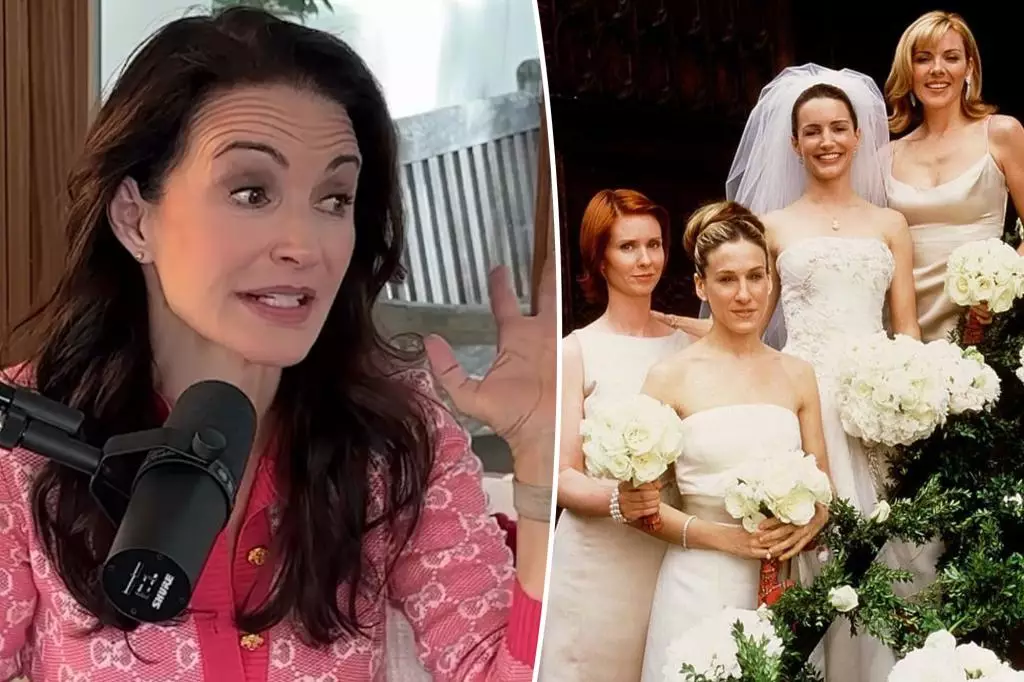When one thinks of the iconic TV series “Sex and the City,” the extravagant fashion, witty banter, and the vibrant personalities of its four leading ladies come to mind. However, behind the glamour, there lie tales of tension and wardrobe disputes that have become part of the show’s lore. A recent discussion brought to light a fascinating anecdote regarding the set’s memorable wardrobe dilemma involving two of its beloved characters, Charlotte York and Carrie Bradshaw, played respectively by Kristin Davis and Sarah Jessica Parker.
During a recent episode of the podcast “Are You a Charlotte?” hosted by Davis herself, a throwback to the third season’s wedding of Charlotte and Trey MacDougal revealed lingering frustration on Parker’s part concerning her character’s bridesmaid dress. The conflict was rooted in Parker’s aversion to the color beige, which she ultimately had to wear as Charlotte’s best friend. The episode not only showcased the stress of filming a pivotal scene but highlighted how deeply the cast was invested in the character’s portrayal and appearance.
Davis indicated that the color choice was problematic for Parker, noting that “Sarah did not want to wear beige”—a wardrobe decision that seemingly affected her through the years. It’s an intriguing narrative as it reflects the importance of wardrobe in defining character identity on the show, illustrating the subjective nature of aesthetics in a series celebrated for its fashion.
Davis revealed that Parker’s dissatisfaction with the dress led to a creative, albeit drastic, modification. According to showrunner Michael Patrick King, Parker reportedly took matters into her own hands, altering the Vera Wang dress she was assigned. Her changes included cutting the dress and even integrating tartan fabrics—an homage to Trey’s Scottish heritage, as he was wearing a kilt during the ceremony. Such bold alterations provide an amusing glimpse into the tension that can brew among creative individuals when artistic visions clash.
King described the filming of Charlotte’s wedding as one of “the longest days of [his] life,” hinting at the stress and possibly the chaos that surrounded the shoot. This incident invites the audience to appreciate that what may seem like a trivial fashion choice can escalate into emotional outbreaks, especially when the stakes are as personal as character portrayal in a beloved series.
Davis recounted moments of Parker confiding her frustration over the dress, responding to Parker’s concerns with straightforward honesty. “But, it’s Charlotte’s wedding. Of course, you’d be wearing beige.” This exchange not only showcases Davis’s loyalty to the narrative but also highlights the complexities of their friendship, forging a bond more profound than just on-screen camaraderie.
The conversation serves as a reminder that behind every stylish ensemble lies a story, a personal experience that can enhance, or sometimes threaten, the intricate web of relationships among the cast. It underscores the importance of communication and friendship amidst the inevitable pressures of the entertainment industry.
Beyond the drama of the bridesmaid dress, this anecdote acts as a lens to explore the evolution of fashion choices in “Sex and the City.” Davis reflected on the stark contrast between the coordinated bridesmaids’ dresses in Charlotte’s wedding and the individualistic attire seen during Carrie’s own wedding scenes. This highlights the show’s progression in presenting its characters, embracing their unique personalities rather than limiting them to similar aesthetics.
Davis’s mention of her cherished black Zac Posen gown known as the “Black Swan,” serves as a delightful nod to fans amid discussions of fashion legacy—a legacy that continues to influence contemporary styling while reminding audiences of character-driven narratives. The variance in styles at key moments cements the notion that fashion on “Sex and the City” was not merely a backdrop, but a crucial element that shaped character journeys and the storyline’s emotional core.
Ultimately, the wardrobe dispute surrounding Charlotte’s wedding offers insight into the intricate relationship dynamics at play within the series. It also highlights a vital aspect of artistic creation, where personal investment can lead to both cherished memories and playful conflicts, threading the essence of the characters into luxuriously crafted fabrics. As viewers reminisce about the show’s glamorous moments, they may consider the tangled threads of relationships and emotional investment that lie beneath the surface.

